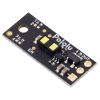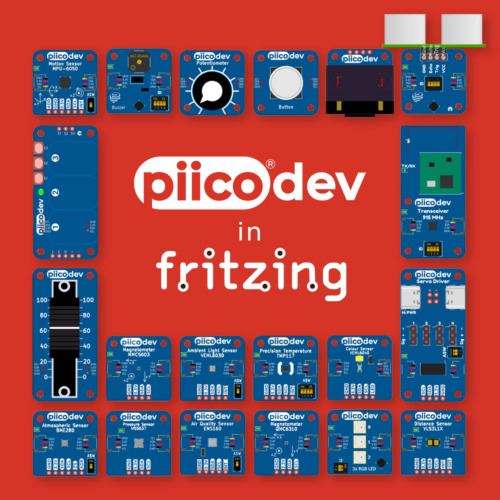Pololu Distance Sensor with Pulse Width Output, 130cm Max
Available with a lead time
Expect dispatch between Dec 02 and Dec 05
Quantity Discounts:
- 10+ $35.35 (exc GST)
- 25+ $34.24 (exc GST)
This compact sensor makes it possible to measure the distance of objects up to about 130 cm (50") away using a simple digital pulse width interface (similar to a hobby servo control signal). It uses a short-range lidar module to precisely measure how long it takes for emitted pulses of infrared, eye-safe laser light to reach the nearest object and be reflected back, allowing for 1 mm resolution. As long as the sensor is enabled, it takes continuous distance measurements and encodes the ranges as the widths of high pulses, which can then be timed by a microcontroller using a single digital input.
 |
 | |||||
| #4050: Digital output, 5cm | 5 cm | < 5 mm | 145 Hz | 0000 | irs16a |
| #4052: Digital output, 10cm | 10 cm | < 5 mm | 115 Hz | 0010 | |
| #4054: Digital output, 15cm | 15 cm | < 5 mm | 95 Hz | 0100 | |
| #4066: Digital output, 25cm | 25 cm | < 1 mm | 100 Hz | 0000 | irs17a |
| #4067: Digital output, 50cm | 50 cm | < 1 mm | 100 Hz | 0001 | |
| #4069: Digital output, 100cm | 100 cm | < 1 mm | 100 Hz | 0011 | |
| #4077: Digital output, 200cm | 200 cm | < 1 mm | 30 Hz | 1011 |
| Pulse width output (provides distance measurement) | |||||||
| #4064: Pulse width output, 50cm max | ~50 cm | 1 cm | 3 mm | 50 Hz | 1110 | irs16a | |
| #4071: Pulse width output, 130cm max | ~130 cm | 4 cm | 1 mm | 100 Hz | 0101 | irs17a | |
| #4079: Pulse width output, 300cm max | ~300 cm | 4 cm | 2 mm | 30 Hz | 1101 | ||
1 Effective range depends on object reflectivity and ambient lighting conditions.
2 Objects closer than the minimum distance can still be detected, but the measured distance might be inaccurate. The minimum detection range is < 5 mm for irs16a boards and < 1 mm for irs17a boards.
These are the output graphs for the digital output versions that just report if an object is in their detection range:
|
|
| |||
|
|
| |||
|
The output graph is a bit different for the versions that use a pulse width to encode the measured distance. The output for these versions is similar to hobby servo control signals and is shown below as a function of time:
 |
Comparison to Sharp Digital Distance Sensors
These Pololu Digital Distance Sensors have the same form factor and pinout as Pololu's carrier boards for the Sharp/Socle GP2Y0D8x digital distance sensors. They are available in the same 5 cm, 10 cm, and 15 cm ranges, in addition to longer ranges of up to several meters. This means they can be used as replacements for these older modules, which are based on sensors from Sharp/Socle that are no longer in production, and the longer-range versions can serve as upgrades that provide enhanced detection and measurement capabilities. The sensors on these newer units are much thinner than the Sharp modules, so the zero-range point is approximately 7 mm closer to the PCB, and the beam angle of the newer units is wider. The pictures below show side-by-side comparisons of the two:
|
|
|
People often buy this product together with:
 | Pololu Distance Sensor with Pulse Width Output, 50cm Max |
 | Pololu Digital Distance Sensor 50cm |
 | Pololu Digital Distance Sensor 100cm |
Dimensions
| Size: | 0.85" × 0.35" × 0.136" |
|---|---|
| Weight: | 0.4 g |
General specifications
| Resolution: | 1 mm |
|---|---|
| Maximum range: | 130 cm1 |
| Sampling rate: | 100 Hz2 |
| Minimum operating voltage: | 3.0 V |
| Maximum operating voltage: | 5.5 V |
| Supply current: | 30 mA3 |
| Output type: | digital pulse width |
Identifying markings
| PCB dev codes: | irs17a |
|---|---|
| Other PCB markings: | 0J13150 |
Notes:
- 1
- This maximum is only achievable for high-reflectance objects in good ambient conditions; lower-reflectivity targets or poor ambient conditions will reduce the maximum range.
- 2
- Minimum.
- 3
- Typical average current draw when enabled; disabling via the EN pin reduces it to around 0.4 mA.
File downloads
-
Dimension diagram of the Pololu Digital Distance Sensors (irs17a) (193k pdf)
-
3D model of the Pololu Digital Distance Sensors (irs17a) (5MB step)
-
Drill guide for the Pololu Digital Distance Sensors (irs17a) (22k dxf)
This DXF drawing shows the locations of all of the board’s holes.
Recommended links
Exact shipping can be calculated on the view cart page (no login required).
Products that weigh more than 0.5 KG may cost more than what's shown (for example, test equipment, machines, >500mL liquids, etc).
We deliver Australia-wide with these options (depends on the final destination - you can get a quote on the view cart page):
- $3+ for Stamped Mail (typically 10+ business days, not tracked, only available on selected small items)
- $7+ for Standard Post (typically 6+ business days, tracked)
- $11+ for Express Post (typically 2+ business days, tracked)
- Pickup - Free! Only available to customers who live in the Newcastle region (must order online and only pickup after we email to notify you the order is ready). Orders placed after 2PM may not be ready until the following business day.
Non-metro addresses in WA, NT, SA & TAS can take 2+ days in addition to the above information.
Some batteries (such as LiPo) can't be shipped by Air. During checkout, Express Post and International Methods will not be an option if you have that type of battery in your shopping cart.
International Orders - the following rates are for New Zealand and will vary for other countries:
- $12+ for Pack and Track (3+ days, tracked)
- $16+ for Express International (2-5 days, tracked)
If you order lots of gear, the postage amount will increase based on the weight of your order.
Our physical address (here's a PDF which includes other key business details):
40 Aruma Place
Cardiff
NSW, 2285
Australia
Take a look at our customer service page if you have other questions such as "do we do purchase orders" (yes!) or "are prices GST inclusive" (yes they are!). We're here to help - get in touch with us to talk shop.
Have a product question? We're here to help!
Guides
The Maker Revolution
Projects
PiicoDev Ecosystem In Fritzing
10" Home Lab Testing Rack
WLED Hourglass Theatre Prop - DMX Over Wi-Fi!
Makers love reviews as much as you do, please follow this link to review the products you have purchased.
























Product Comments